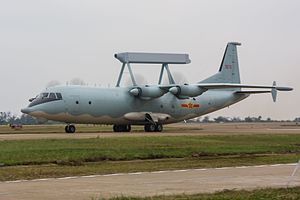Shaanxi KJ-200
This article needs additional citations for verification. (June 2017) |
| KJ-200 | |
|---|---|

| |
| KJ-200 | |
| Role | Airborne early warning and control (AEW&C) |
| National origin | China |
| Manufacturer | Shaanxi Aircraft Corporation |
| Primary user | People's Liberation Army Air Force People's Liberation Army Navy |
| Number built | 11[1] |
| Developed from | Shaanxi Y-8 |
The KJ-200 (Chinese: 空警-200; pinyin: Kōngjǐng Liǎngbǎi; literally: "aerial warning-200") NATO reporting name: Moth or Y-8 Balance Beam system, is an airborne early warning and control (AEW&C) program developed by Shaanxi Aircraft Corporation. (KJ is from the first characters of the Pinyin spelling of 空警, (Kōng Jǐng), short for 空中预警 (Kōng Zhōng Yù Jǐng), which means Airborne Early Warning).
Design and development
[edit]The key component of this aircraft is an AESA radar system, visually similar to the Saab Erieye system, mounted on struts above the rear fuselage, as well as ventral sensor domes. The platform of this aircraft is based on the Shaanxi Y-8F-600 and it has been reported that Pratt & Whitney Canada PW150B turboprops and Honeywell avionics have been incorporated.
The general designer of the KJ-200 is Ouyang Shaoxiu (欧阳绍修),[2] the same general designer of the Y-8. According to Ouyang the KJ-200 has been significantly modified (around 80%) from the original Y-8.[3] including the adoption of a glass cockpit.[4]
Operational history
[edit]The project experienced a major setback in 2006, when a KJ-200 crashed into a mountain in Guangde County while undergoing tests.
During the National Day of the People's Republic of China military parade 1 October 2009, a KJ-200 took the role as a lead aircraft.[5]
In February 2017 a US Navy Lockheed P-3 Orion and a KJ-200 inadvertently came close to each other over the South China Sea. The aircraft were within 1,000 feet (300 meters) of each other.[6][7]
Variants
[edit]- KJ-200
- Base variant.
- KJ-200A
- Modified KJ-200 with revised nose section and new electronics. First observed in December 2016.[8]
- KJ-200AG
- KJ-200A with additional inflight air refueling probe.[8]
- KJ-200H
- Variant for PLA Navy.[8]
- KJ-200B
- First observed in 2016. Entered service in 2023.[8]
Operators
[edit]- People's Liberation Army Air Force - 5 KJ-200[9]
- People's Liberation Army Navy Air Force - 6 KJ-200H[10]
See also
[edit]Related development
Aircraft of comparable role, configuration, and era
References
[edit]- ^ "World Air Force 2015" (PDF). Flightglobal. Archived (PDF) from the original on 2014-12-19. Retrieved 2019-05-17.
- ^ "空警-200总师欧阳绍修:首次采用玻璃化座舱". Sina. Archived from the original on 18 May 2015. Retrieved 26 December 2014.
- ^ KJ-200 vs Y-8 Archived 2013-11-05 at the Wayback Machine,
- ^ "总师称中国空警200上首次采用玻璃化座舱". Netease. Archived from the original on 5 November 2013. Retrieved 26 December 2014.
- ^ "KJ-200 in 2009 National Day Parade". AirForceWorld.com. 2011-02-13. Archived from the original on 2010-11-01. Retrieved 2011-02-13.
- ^ U.S., China military planes come inadvertently close over South China Sea February 10, 2017 Archived April 30, 2019, at the Wayback Machine Reuters Retrieved February 12, 2017
- ^ Chinese and US aircraft in 'unsafe' encounter January 10, 2017 Archived February 12, 2017, at the Wayback Machine CNN Retrieved February 12, 2017
- ^ a b c d Newdick, Thomas; Rupprecht, Andreas (5 April 2023). "China's Massive Fleet Of Radar Planes And The Strategy Behind It". The War Zone.
- ^ Rupprecht, Andreas (2018). Modern Chinese Warplane: Chinese Air Force - Aircraft and Units. Harpia Publishing. p. 92. ISBN 978-09973092-6-3.
- ^ Rupprecht, Andreas (2018). Modern Chinese Warplane: Chinese Naval Aviation - Aircraft and Units. Harpia Publishing. p. 29. ISBN 978-09973092-5-6.
External links
[edit]
